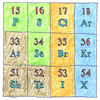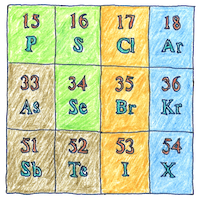Dmitri Mendeleev
chemistry
periodic table

|
Periodic table
Many miracles of modern medicine derive from application of the patterns of atomic properties. If that’s not true, at least it alliterates. Against the tendency of the universe toward disorder is the child’s fascination with stacks of wooden blocks and the poet’s liking for repeated vowels and consonants. Dmitri Mendeleev arranged cards describing the known elements as in a game of Patience in columns by chemical property and rows by atomic weight. Putting himself into a trance, he found “all the elements fell into place as required.” Against the tendency of the universe toward disorder is the inherent order of the elements themselves. In this fairy tale, as sunlight pours over chaos, antientropic forces take advantage of tendencies in the elements themselves to recombine into shapes useful for the perpetuation of life.
Filling the gaps
Mendeleev’s tabular arrangement of the elements made sense only when he left gaps. He was thus able to predict the properties of 22 elements then unknown. Ezra Pound praised ancient cartographers because they left blank areas on their maps for parts of the world they didn’t know. We are performing an experiment whose result is not determined. Go find the missing elements.
Fact and ritual
We memorize our multiplication tables (the familiar rote learning of childhood), but we are uneasy with the periodic table. Uneasy with the lies we tell ourselves, uneasy with the hint of damning truth, the shock of realizing all our knowledge, if not wrong, is at least misleading. We can explain the effects of gross manipulations but the essence is still pristine and unknown. Touch that and it might explode in our faces.
Elements
The element of ornament The element of elements Could be one Could be many The element of suspense The element of surprise



The periodic table made so much sense of the series of elements that had been discovered at the time (about sixty elements) that Mendeleev was able to predict the properties of eight elements that had not yet been discovered. In the table, elements are ordered by their atomic weights. Each column, called a group, includes elements of similar properties, such as the alkali metals and the noble gases. Each row, called a period, shows a trend such as ionization energy and electronegativity. The table provides a useful framework for understanding chemical behaviors.
See also in The book of science:
Readings in wikipedia:
Other readings: